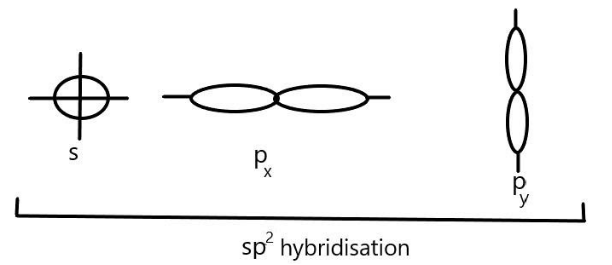
Answer
430.5k+ views
Hint: As we know that the atomic orbitals combine to form a new set of equivalent orbitals known as the hybrid orbitals and it helps in explaining the shape of molecules and equivalency of bonds. It can be classified into $sp,s{p^2},s{p^3}$ and so on which involves one s-orbital and one p-orbital, one s and two p-orbitals etc.
Complete answer:
As we know that hybridisation is a theoretical concept which has been introduced to explain the structural properties such as shape of molecule and equivalency of bonds etc which cannot be explained by simple theories of valency.
We also know that there are many different types of hybridisation depending upon the types of orbitals involved in mixing like $sp,s{p^2},s{p^3},s{p^3}d$ etc. let us talk about $s{p^2}$ hybridisation among these.
We can see that in $s{p^2}$ hybridisation, one s-orbital and two p- $({p_x}\;\& \;{p_y})$ orbitals of one atom hybridise to give three equivalent $s{p^2}$ hybrid orbitals. These three $s{p^2}$ hybrid orbitals are directed towards the three corners of an equilateral triangle with an angle of ${120^\circ }$ and give a triangular geometry to the molecule. We can represent it as:

$s{p^2}$ hybrid orbitals are larger in size than the $sp$-hybrid orbitals but slightly smaller than that of $s{p^3}$. Examples of $s{p^2}$ hybridisation includes the compounds of boron like $B{F_3},BC{l_3}$ and $B{H_3}$ as well as aluminium and carbon containing compounds such as $AlC{l_3}$ and $C{H_2} = C{H_2}$respectively.
Note:Always remember that $s{p^2}$ hybridisation involves the mixing of one s-orbital and two p-orbitals which includes the promotion of one electron in the s-orbital and the one to the any one of the p-orbital whose combination creates a three new hybrid orbitals of equivalent energy levels. The $s{p^2}$ hybridised orbitals possess a trigonal planar geometry of molecules and these hybrid orbitals are more effective in forming stable bonds than the pure atomic orbitals.
Complete answer:
As we know that hybridisation is a theoretical concept which has been introduced to explain the structural properties such as shape of molecule and equivalency of bonds etc which cannot be explained by simple theories of valency.
We also know that there are many different types of hybridisation depending upon the types of orbitals involved in mixing like $sp,s{p^2},s{p^3},s{p^3}d$ etc. let us talk about $s{p^2}$ hybridisation among these.
We can see that in $s{p^2}$ hybridisation, one s-orbital and two p- $({p_x}\;\& \;{p_y})$ orbitals of one atom hybridise to give three equivalent $s{p^2}$ hybrid orbitals. These three $s{p^2}$ hybrid orbitals are directed towards the three corners of an equilateral triangle with an angle of ${120^\circ }$ and give a triangular geometry to the molecule. We can represent it as:

$s{p^2}$ hybrid orbitals are larger in size than the $sp$-hybrid orbitals but slightly smaller than that of $s{p^3}$. Examples of $s{p^2}$ hybridisation includes the compounds of boron like $B{F_3},BC{l_3}$ and $B{H_3}$ as well as aluminium and carbon containing compounds such as $AlC{l_3}$ and $C{H_2} = C{H_2}$respectively.
Note:Always remember that $s{p^2}$ hybridisation involves the mixing of one s-orbital and two p-orbitals which includes the promotion of one electron in the s-orbital and the one to the any one of the p-orbital whose combination creates a three new hybrid orbitals of equivalent energy levels. The $s{p^2}$ hybridised orbitals possess a trigonal planar geometry of molecules and these hybrid orbitals are more effective in forming stable bonds than the pure atomic orbitals.
Recently Updated Pages
Fill in the blanks with suitable prepositions Break class 10 english CBSE

Fill in the blanks with suitable articles Tribune is class 10 english CBSE

Rearrange the following words and phrases to form a class 10 english CBSE

Select the opposite of the given word Permit aGive class 10 english CBSE

Fill in the blank with the most appropriate option class 10 english CBSE

Some places have oneline notices Which option is a class 10 english CBSE

Trending doubts
Fill the blanks with the suitable prepositions 1 The class 9 english CBSE

How do you graph the function fx 4x class 9 maths CBSE

Which are the Top 10 Largest Countries of the World?

What is the definite integral of zero a constant b class 12 maths CBSE

The Equation xxx + 2 is Satisfied when x is Equal to Class 10 Maths

Differentiate between homogeneous and heterogeneous class 12 chemistry CBSE

Define the term system surroundings open system closed class 11 chemistry CBSE

Full Form of IASDMIPSIFSIRSPOLICE class 7 social science CBSE

Change the following sentences into negative and interrogative class 10 english CBSE




